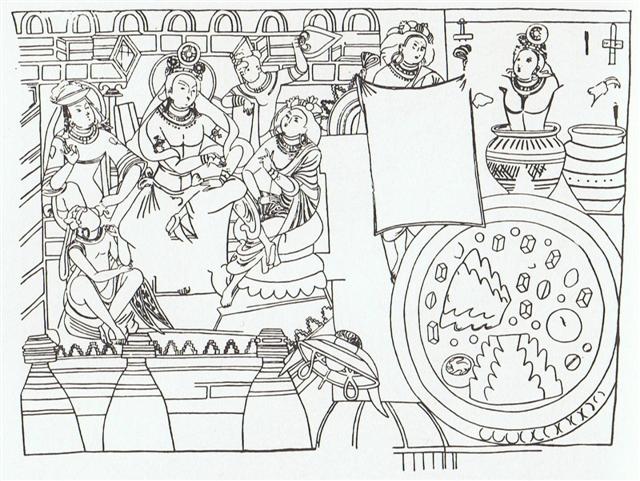6. Allen: "From about the year 1730 before our era he was the Princeps signorum coelestium, Princeps zodiaci, and the Ductor exercitus zodiaci, continuing so through Hipparchos' time; Manilius writing of this: The Ram having pass'd the Sea serenely shines, And leads the Year, the Prince of all the Signs. But about AD 420 his office was transferred to Pisces." (1730 + 420) * 12 = 25800. This Sea in the sky probably is beginning at the Cargo Boat from where the Milky Way 'inundates' the ecliptic path of Sun:
The Goatfish corresponds to our Capricorn and mountain goats are great climbers. A quarter later is the Hired Man which is drawn like a goat rather than a ewe. Maybe the Old Man has hired someone else to take his place from the time when he sailed away (cfr Eagle & Dead Man) until his return (at which time the hired man was finished - his head is looking back). We can imagine a 'Place Aloft' (similar to Poike), north of the tropical belt, which the Sun King reached by the path of the Milky Way. Beyond the 'Cloth' is Aquarius and then we can see the head of a goat (above an empty jar with a single 'leg'). From the 'Cloth' to the end with the goat-head the figures are placed high up:  But the story is surely complicated, for instance: ... Crook (Auriga) The Crook depicts a shepherd tending a goat-kid. It naturally symbolizes the spring-time when the majority of calves, lambs and kids are born in the cattle-folds. The shepherd also symbolizes the king, who figuratively guides his people on the paths of safety and security. The Crook therefore appropriately rises in the first month of the year when the king was enthroned and empowered to rule for another year. Manilius wrote: 'The Ram having pass'd the Sea serenely shines, And leads the Year, the Prince of all the Signs.' When the ram is shining 'serenely' it ought to mean Moon (Serena) is still in charge, although 'land' has been reached. The boy is born on the 'reef': ... Fakataka swims and swims, reaching another land. She goes there and stays on the upraised reef in the freshwater pools on the reef, and there delivers her child, a boy child. She gives him the name Taetagaloa. When the baby is born a golden plover flies over and alights upon the reef. (Kua fanau lā te pepe kae lele mai te tuli oi tū mai i te papa). And so the woman thus names various parts of the child beginning with the name 'the plover' (tuli): neck (tuliulu), elbow (tulilima), knee (tulivae). Greek σελήνη, selene, means Moon (and r and l are hard to distinguish from each other). |
